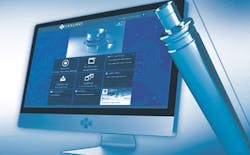Q&A: Tablet production
Q. What are the most common tablet production problems?
Although there are quite a few issues that may arise during tablet manufacture, by far the most common tablet production problem is sticking. Sticking is when material adheres to the surface of the punch tip face. This build-up of granule results in tablet defects, which starts out as a negative effect on the tablet appearance and can transition through other stages to double compression and potentially damage to tooling and press. As a minimum sticking result in the removal of tablet tooling from production whilst regular cleaning and maintenance take place to remove the granule. The knock-on effect is costly as tablet press downtime and reduced productivity is inevitable.
There are several reasons why granule can stick to a punch face, but it usually boils down to either inappropriate tooling specification or problematic formulation/environment issues. One of the known influences in formulation sticking is the Van der Waals force. This is the attraction of intermolecular forces between molecules. Elements within the formulation are naturally attracted to elements within the tablet punch material. These forces are very weak but in mass their behavior changes. When lots of these forces interact on the face of a tablet it can cause sticking.
WANT TO BECOME A TABLET PRO?
Attend our Pharma Manufacturing Thought Leadership series webinar
REGISTER NOW
Sticking —when material adheres to the surface of the punch tip face — results in tablet defects, which starts out as a negative effect on the tablet appearance and can transition through other stages, potentially damaging the tooling and press.
It is worth highlighting that it is not just moisture within the formulation itself that can be problematic, moisture can also enter the production process through the environment in which the tablet is compressed. Excess humidity in the compression chamber will have a significant effect on compression making the formulation adhere to the punch tips. As a note of caution, very dry formulations can be just as problematic as the granulation can often generate static electricity leading to sticking.
Another challenge when it comes to sticking is whether the formulation is characterized with plastic or elastic properties. This is where particles in the formulation behave differently when under compression and can either stay deformed or return to its original shape. ‘Elastic’ particles will change shape during applied stress, but this is not always permanent. The particle will return to its original shape when the applied stress has ended. If ‘plastic’ properties are incorporated they will be permanently deformed when stress is applied above its elastic limit. The force used and the length of time in compression can affect the way the formulation reacts, this in turn, can lead to sticking issues.
Although the formulation being compressed can impact the risk of sticking, the tablet’s design also has a significant influence. The right tablet design will help to avoid many downstream manufacturing problems like sticking and is essential in guaranteeing a problem free, high quality, end product.
Q. What can manufacturers do to prevent and/or fix these problems?
Sticking can be avoided but ideally steps should be in place within the initial stages of design. Good tablet design is imperative, and it is something that should be strongly considered. It is important to consult with an expert tablet designer as early on in the process as possible, this can ensure that the tablet design is robust and producible in a rigorous tablet manufacturing environment. By making just a few simple changes to the design, it can prevent problems like sticking and picking. Within the initial design stage, consideration will also be taken to incorporate the appropriate tool coating where necessary. Tool coatings are commonly used to offer a solution to sticking, wear or corrosion issues.
Because sticking negatively impacts pharmaceutical manufacturing so greatly resulting in tablet press downtime and reduced tablet output, an extensive two-year study was undertaken by I Holland to investigate the cause of why formulations stick to punch tip faces. A predictive model was developed to recognize the correct punch or die coating solution for sticky formulations.
This specialized service (Tabletting Science Anti-Stick Research or TSAR) uses an algorithmic model to quickly calculate the most likely anti-stick coating to apply to compression tooling based on the properties and characteristics of the formulation. For example, surface chemistry, temperature, humidity and size of the granule were studied.
Because the physical properties of any sticky formulation are unique, there is no universal anti-stick solution. Using TSAR eliminates the need to carry out expensive in the field testing which is time consuming and requires the tablet manufacturer to take time out of tablet production to run a test set of coated punches. Ultimately TSAR offers a quick solution to sticking problems.
Another consideration to prevent sticking is to look at the dwell time. As already touched upon in the first answer, many tablet formulations are dwell sensitive and the time they are under compression has a huge impact on the final product. If a formulation displays difficult non-cohesive characteristics, for example, plastic or elastic properties, the amount of time the formulation is under compression has an impact on production, for example, stopping the press due to problems like sticking. Tablet manufacturers will often apply more compression force or slow the press down to solve sticking problems. Either or both of these can often help but can affect productivity and tooling and press lifetime. By incorporating new technology like extended dwell flat tooling (XDF), dwell time can be increased to form quality tablets and at an increased output. This XDF tooling is designed to be compatible with an existing tablet press without the need for time-consuming and expensive modifications.
Q. Can you offer some general advice for those looking to optimize tablet manufacture?
To optimize tablet production, you must combine many factors, all of which will lead to better processes and a quality end product. A very important piece of advice when it comes to manufacturing optimization is to utilize precise tooling specifications at the earliest stages of the tablet design process.
When it comes to tablet production, online training should be recognized as an important tool with which to share knowledge and improve technical skills and understanding.
Something else to consider, but perhaps less obvious is education. It is not just the tooling that is key to optimized manufacturing processes, ensuring staff are skilled and knowledgeable is also essential. Do they know how to maintain tooling correctly, can they troubleshoot common problems? Face to face training is available and a good tooling manufacturer will run educational courses, but it isn’t always easy for busy staff to access these seminars and courses. E-learning programs are starting to become available for the pharmaceutical industry. These can incorporate comprehensive and flexible courses in a wide variety of disciplines and now training can now take place within the workplace. The material can be delivered in a multimedia format incorporating engaging animations, webinars and validated by interactive quizzes to ensure that the key learning points are taken onboard.
Online training should be recognized as an important tool with which to share knowledge and improve technical skills and understanding. It is designed for everyone from director level to engineers and operators. Modern e-learning even incorporates courses with a hierarchical system giving training managers and supervisors full audit, tracking and reporting of employee development and certification.
By ensuring those involved in the tablet manufacturing process are skilled and informed will significantly improve production.
Q. What is the most important piece of the production puzzle when it comes to tablet manufacturing?
As the saying goes ‘knowledge is power’, and this is true when it comes to optimizing tablet manufacture. By ensuring the correct skills, procedures and tooling are in place, manufacturing processes will improve.
The efficient and accurate management of punches and dies is vital to optimize profitability and productivity in modern tablet manufacturing. The most proficient way to do this is through computer-based monitoring systems.
Tablet manufacturers are looking for increased capacity, flexibility, speed of response and robust traceability all with the core objective of maximized press uptime. Implementation of a tooling management system can significantly improve tooling inventory availability. The data can also provide information to effectively measure areas of performance by way of showing what and how many products have been produced and a summary of any production issues experienced.
Within pharmaceutical manufacturing, the importance of knowing where tools are, and what condition they are in, should be a priority. Without this information either unnecessary tooling replacements are made, reducing productivity, or punches are forced into use when they should be in maintenance or replaced. The consequence of this can have negative effects on the end tablet or even damage costly press equipment when it is found that the tooling being used does not meet the highly demanding process of tablet manufacture. The results are rejected tablets, wasted formulation, press downtime and costly press repair or replacement.
Damage through handling can be another significant production failing. There are several stages of the tablet manufacturing process where damage can take place, including unpacking the tooling, loading/unloading the tools in or out of the tablet press, during tool cleaning/maintenance procedures and storage/transportation. If damage occurs it can lead to the production of poor-quality tablets, and even further damage to both the tooling and the tablet press. It is important to understand the delicate nature of the tooling and operate good tool care, maintenance, storage and handling procedures, to keep this problem to a minimum. This should be done by adopting a planned process for tooling maintenance and storage and the incorporation a management system to monitor all tooling.
If you know the tooling being used is correct and up to the job, and the staff working the equipment are skilled and able, tablet optimization will ultimately be efficient and effective.
Alex Bunting is a Marketing Manager for I Holland Ltd.


